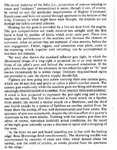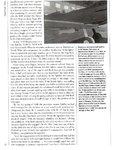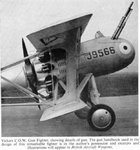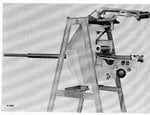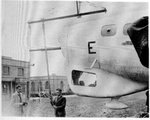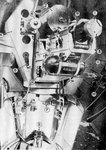Navigation
Install the app
How to install the app on iOS
Follow along with the video below to see how to install our site as a web app on your home screen.
Note: This feature may not be available in some browsers.
More options
You are using an out of date browser. It may not display this or other websites correctly.
You should upgrade or use an alternative browser.
You should upgrade or use an alternative browser.
RAF guns and ammunition
- Thread starter Tony Williams
- Start date
Ad: This forum contains affiliate links to products on Amazon and eBay. More information in Terms and rules
More options
Who Replied?CharlesBronson
Senior Master Sergeant
- Thread starter
- #23
Tony Williams
Airman 1st Class
Vickers 11mm
Actually designed by Vickers, but made in USA and used mostly by the France air Arm in ww1 and some in US Army Air Corps.
Employed mostly in ballon and Zeppelin hunt due the larger incendiary capacity of its ammunition in Spads and some Niueports.
The 11mm Gras-Vickers was actually a French development. They had already converted some of their Hotchkiss M1914 to the 11x59R Gras cartridge (which was the old French army rifle round replaced by the 8mm Lebel) for balloon-busting from the ground. They were already using the .303 Vickers as their standard synch gun, so they modified the Vickers to take the same ammo and put it into service. The US was very interested and acquired some. The British became interested late in the war, but too late to get any into action.
CharlesBronson
Senior Master Sergeant
The 11mm Gras-Vickers was actually a French development
I shall include it in a future "French guns and ammunition topic "
Rare video of the C.O.W 37mm long recoil cannon :
View: https://www.youtube.com/watch?v=Rz1MSHglGP4
vikingBerserker
Lieutenant General
CB, this is some great data!
CharlesBronson
Senior Master Sergeant
You welcome
A little more on 37mm gun
In October 1918, the COW gun was installed in the rear cockpit of an Airco D.H.4, fixed and aimed up. The angle of the installation in at least one ( A2168 ) was about 80 degrees. The gun fired through a hole in the upper wing. The idea was to use this weapon against the large German bombers and Zeppelins, and after some reinforcement to prevent blast damage, testing was successfull. Three D.H.4s with COW guns were put into service. They carried a crew of two; the gunner in the aft cockpit not only loaded the weapon – the breech was inconveniently close to the cockpit floor – but also fired it on a signal from the pilot, who aimed with a ring-and-bead sight. Though two were sent to France, they did not see any combat before the war ended. (A2168 is recorded as flying a sortie against German Gotha bombers in August 1917, but that was presumably still without the COW gun.)
The french however were by far more entuasiatic about it and used in several Voisin airplanes.
A little more on 37mm gun
In October 1918, the COW gun was installed in the rear cockpit of an Airco D.H.4, fixed and aimed up. The angle of the installation in at least one ( A2168 ) was about 80 degrees. The gun fired through a hole in the upper wing. The idea was to use this weapon against the large German bombers and Zeppelins, and after some reinforcement to prevent blast damage, testing was successfull. Three D.H.4s with COW guns were put into service. They carried a crew of two; the gunner in the aft cockpit not only loaded the weapon – the breech was inconveniently close to the cockpit floor – but also fired it on a signal from the pilot, who aimed with a ring-and-bead sight. Though two were sent to France, they did not see any combat before the war ended. (A2168 is recorded as flying a sortie against German Gotha bombers in August 1917, but that was presumably still without the COW gun.)
The french however were by far more entuasiatic about it and used in several Voisin airplanes.
Last edited:
CharlesBronson
Senior Master Sergeant
Schräge Musik isnt german: The F29/27 specifications and fighters:
This called for an aircraft armed with the 37mm Coventry Ordnance Works (COW) cannon that had been evolved during World War I and was thought to have potential as an anti-bomber weapon. The COW gun was to be mounted at an upward angle of at least 45° from the horizontal, with the idea that the fighter would approach enemy bombers from below and astern.
Both Westland and Vickers submitted designs:
Vickers Type 161:
This called for an aircraft armed with the 37mm Coventry Ordnance Works (COW) cannon that had been evolved during World War I and was thought to have potential as an anti-bomber weapon. The COW gun was to be mounted at an upward angle of at least 45° from the horizontal, with the idea that the fighter would approach enemy bombers from below and astern.
Both Westland and Vickers submitted designs:
Vickers Type 161:
Attachments
Last edited:
vikingBerserker
Lieutenant General
Very nice!!
I bet this is common knowledge (is it?), but Spitfire Mk.I's .303 machineguns were targeted so that they all shot in the area of 2 feet in diameter at 250 yards. This meant that one second burst sent 10 lb of metal to that area, if well adjusted and fired. -Robert Jackson: Spitfire (book)
This information changed my view of Spitfire's "ineffective" armament.
This information changed my view of Spitfire's "ineffective" armament.
- Thread starter
- #30
Tony Williams
Airman 1st Class
The armament of the RAF fighters was initially harmonised at 400 yards - not because they expected the shooting to be done at that distance, but because at shorter distances this provided a spread of fire which could cover the fuselage and engines of a twin-engined bomber. They reduced the harmonisation range to 250 yards when they found out that they needed to maximise concentration of fire to have any effect. Even so, some bombers escaped with hundreds of bullet holes in them.
CharlesBronson
Senior Master Sergeant
Experimental 40mm emplacement in B-17
An coastal command Boeing was modified with an Bristol b-16 nose turrte for firing the heavy Vickers Class S for antisubmarine work. The installation and testing was completed in early 1944 but apparently wasnt used in action.
An coastal command Boeing was modified with an Bristol b-16 nose turrte for firing the heavy Vickers Class S for antisubmarine work. The installation and testing was completed in early 1944 but apparently wasnt used in action.
Attachments
MiTasol
Captain
Regarding superiority of Browning over Vickers.
Long ago I read that the Japanese fixed a major problem that plagued the Vickers (breaking firing? pin? spring) by making their spring out of three pieces of wire twisted together before being heat treated and coiled to form the spring.
IF correct that spring problem MAY have been why the Browning was chosen.
Long ago I read that the Japanese fixed a major problem that plagued the Vickers (breaking firing? pin? spring) by making their spring out of three pieces of wire twisted together before being heat treated and coiled to form the spring.
IF correct that spring problem MAY have been why the Browning was chosen.
CharlesBronson
Senior Master Sergeant
Combat camera (not very clear, i must admit) of typhoon showing the effect of 20mm Hispano fire on trawlers and barges.
Users who are viewing this thread
Total: 1 (members: 0, guests: 1)


